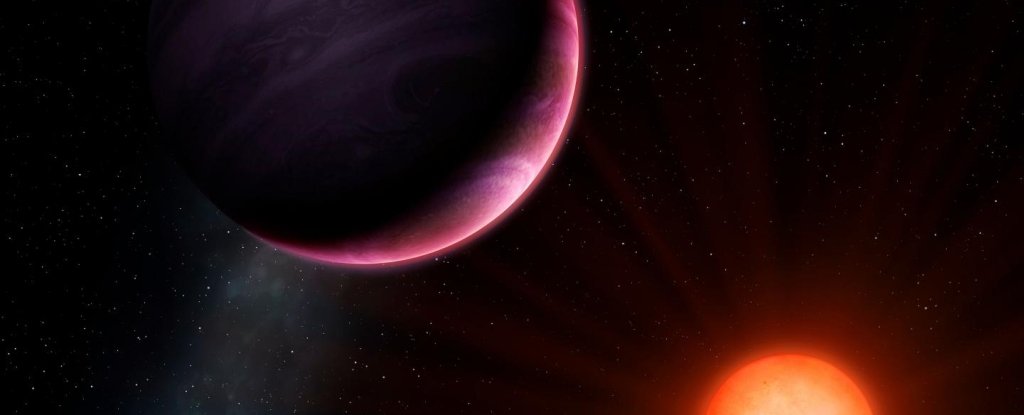Welcome to DU!
The truly grassroots left-of-center political community where regular people, not algorithms, drive the discussions and set the standards.
Join the community:
Create a free account
Support DU (and get rid of ads!):
Become a Star Member
Latest Breaking News
General Discussion
The DU Lounge
All Forums
Issue Forums
Culture Forums
Alliance Forums
Region Forums
Support Forums
Help & Search
Science
Related: About this forumThis Monster Planet With a Tiny Star Poses a Planetary Formation Puzzle
How did it get so big!?

MICHELLE STARR 1 NOV 2017
Astronomers have found something they thought was impossible: a gas giant roughly the size of Jupiter orbiting a white dwarf half the mass and size of the Sun.
The planet, called NGTS-1b, is a record breaker - the largest planet compared to its star ever found, at a ratio that scientists weren't even sure was possible. This discovery could pose a challenge to our current theories about planetary formation.
"The discovery of NGTS-1b was a complete surprise to us - such massive planets were not thought to exist around such small stars," said lead researcher Daniel Bayliss of the University of Warwick.
"This is the first exoplanet we have found with our new NGTS facility and we are already challenging the received wisdom of how planets form.
More:
http://www.sciencealert.com/monster-planet-tiny-star-poses-puzzle-planetary-formation
InfoView thread info, including edit history
TrashPut this thread in your Trash Can (My DU » Trash Can)
BookmarkAdd this thread to your Bookmarks (My DU » Bookmarks)
7 replies, 1817 views
ShareGet links to this post and/or share on social media
AlertAlert this post for a rule violation
PowersThere are no powers you can use on this post
EditCannot edit other people's posts
ReplyReply to this post
EditCannot edit other people's posts
Rec (9)
ReplyReply to this post
7 replies
 = new reply since forum marked as read
Highlight:
NoneDon't highlight anything
5 newestHighlight 5 most recent replies
= new reply since forum marked as read
Highlight:
NoneDon't highlight anything
5 newestHighlight 5 most recent replies
This Monster Planet With a Tiny Star Poses a Planetary Formation Puzzle (Original Post)
Judi Lynn
Nov 2017
OP
Isn't that misleading? The "tiny star" is still much, much bigger than the planet.
brush
Nov 2017
#3
"NGTS-1b's radius would be between a fifth and a quarter of that of its host star"
muriel_volestrangler
Nov 2017
#5
DarthDem
(5,255 posts)1. Fascinating!
Anyone know where in our sky the star is located? I searched a handful of articles but none of them said. I know it won't be visible to consumer-level telescopes but I'm always curious about such things.
Ptah
(33,032 posts)2. 600 light-years from Earth in the Columba constellation.
NGTS-1b is a confirmed hot Jupiter-sized extrasolar planet orbiting NGTS-1, a red dwarf star about half the mass and radius of the Sun, every 2.65 days. The NGTS-1 system is about 600 light-years from Earth in the Columba constellation. The exoplanet, NGTS-1b, was discovered by the Next-Generation Transit Survey. Daniel Bayliss, of the University of Warwick, and lead author of the study describing the discovery of NGTS-1b, stated, "The discovery of NGTS-1b was a complete surprise to us—such massive planets were not thought to exist around such small stars – importantly, our challenge now is to find out how common these types of planets are in the Galaxy, and with the new Next-Generation Transit Survey facility we are well-placed to do just that."
Parent star
Star NGTS-1[1]
Constellation Columba
Right ascension (?
Declination (?
Apparent magnitude (mV) 14.38[1]
Distance 600[2] ly
(224.0[3] pc)
Spectral type M0.5[1]
Mass (m) 0.617[3] M☉
Radius (r) 0.573[3] R☉
Temperature (T) 3916[1] K
Metallicity [Fe/H] 0.0[3]
https://en.wikipedia.org/wiki/NGTS-1b
Great info. Thanks! ![]()
brush
(53,788 posts)3. Isn't that misleading? The "tiny star" is still much, much bigger than the planet.
muriel_volestrangler
(101,321 posts)5. "NGTS-1b's radius would be between a fifth and a quarter of that of its host star"
That is pretty astounding for a comparison between a star and its planet. Earth is about an eleventh of the radius of Jupiter, for instance, but they're both planets.
Iggo
(47,558 posts)6. Would the star orbit the planet? Or is that not how it works?
Be nice. I'm dumb at a lot of science (but I love it anyway.)
gvstn
(2,805 posts)7. I'm not well versed but the star would have a greater mass than the planet despite its size
So the planet would still orbit the star as gravity is holding it in orbit around the heavier object.
(I'm happy to be corrected but that is the off the top of my head understanding. The article states the star has a mass of 1/2 our sun so it must be denser than our sun in relation to diameter.)